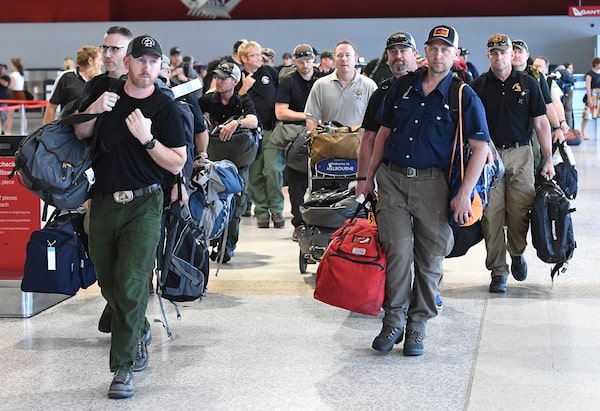
A contingent of 39 firefighters from the United states and Canada arrive at Melbourne Airport in Melbourne, Thursday, January 2, 2020.Julian Smith/The Associated Press
Canadian fire-fighting officials who are helping Australia battle its deadly blazes are bracing for a long fight.
“It’s the scale of the drought here. They have been affected for several years, just countrywide,” said Marc Mousseau in an interview from Brisbane. The result of past droughts is "very, very large fires and severe fire behaviours,” he said.
Mr. Mousseau, a Canadian Interagency Forest Fire Centre (CIFFC) official who is acting as the liaison officer, spent New Year’s Day in Brisbane Airport welcoming the latest wave of Canadian fire-fighting experts who are lending logistical support to an increasingly massive effort.
More than 60 fire-fighting professionals from Canada flew out in December to help Australia manage the crisis. It’s the first such overseas trip arranged by the Winnipeg-based CIFFC, a body formed nearly 40 years ago by disaster-management officials in provincial and federal natural-resources departments.
Canada and Australia are Commonwealth cousins and huge countries with opposite summer seasons, which are when fire risks are greatest. But it is only relatively recently that the two governments have realized that they are natural allies in the fight against wildfires.
A satellite image of Batemans Bay shows smoke and fire from wild bushfires in Australia, on Dec. 31, 2019.EUROPEAN UNION/Reuters
During four of the past five Canadian summers, Australia has sent some of its own experts to help contain blazes in Alberta and British Columbia.
“Since 2015, Australia has helped out Canada immensely ... this is just an opportunity to reciprocate," Mr. Mousseau said.
“A lot of it is just planning and co-ordinating future tactics based on the weather," he said. Canada is sending some fire-behaviour analysts to help in the effort, Mr. Mousseau said.
The Canadian contingent is helping plan everything from the movement of people, equipment and planes, on down to smaller considerations, such as food, laundry and finances, said Melanie Morin, a CIFFC spokeswoman. “You need a team in place that takes care of the most minute things," she said.
On Dec. 3, the initial group of 21 Canadians flew to Australia on a five-week deployment. Their term, which spanned the holiday season, will end this weekend as another 21-member team from Canada relieves them.
A second contingent of 30 Canadians flew out to Australia on Dec. 19. A third wave of 15 flew out on Dec. 30 and marked New Year’s Eve in transit before arriving early Jan. 1.
Such efforts could continue for months, Mr. Mousseau said.
He pointed out that in Canada, there are plentiful lakes and rivers and the onset of a colder season is never all that far away, which is not the case in Australia.
Freshwater “is definitely in short supply here in Australia, so different tactics are used on the fire,” he said. "There’s a lot of burnout operations – you know, clearing and burning. Where we would just find a nice water supply, set up, run hose – they just don’t have that luxury here.”
Our Morning Update and Evening Update newsletters are written by Globe editors, giving you a concise summary of the day’s most important headlines. Sign up today.
 Colin Freeze
Colin Freeze